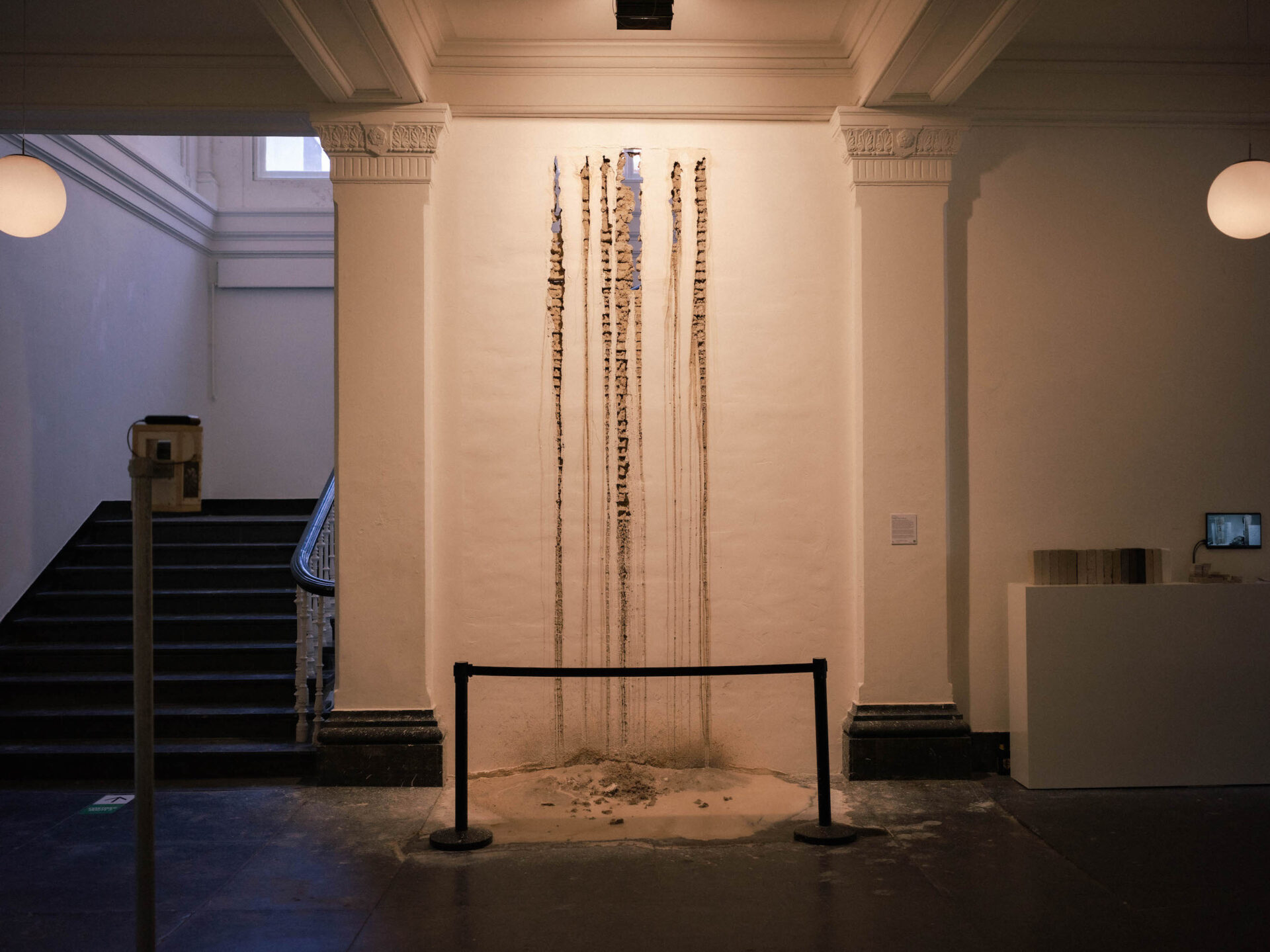
Aldo Brinkhoff
Graduation Shows 2023: KABK
At the Royal Academy of Art (KABK) in The Hague, a wall is falling apart before the visitors’ own eyes. Joris van den Einden discusses the work by Aldo Brinkhoff and a couple of other graduating students.
It is no easy task to select a limited number of artists and artworks at KABK’s graduation show: the grand scale of the academy, the regularly disorienting nature of its building, and the quality of its graduating students provide plenty of challenges to that quest. Walking around the academy, it appears that this year’s graduates often seek to make sense of something. Six projects stand out, each zooming out from the personal and introspective to the collective and the systemic.
Jemima de Jonge (BA Fine Arts)
The entrance to Jemima de Jonge’s cardboard world in A body of water is slightly lowered, forcing many visitors to bow their heads down upon entering the work. After shimmying through, they look up and find themselves transported into a space that feels like the artist’s very imagination itself. Little rooms, corners, nooks, and crannies are dispersed around, inviting the visitor on a quest around the space. This place is dark and the walls are dry, forming a contrast with the illumination of screens and projections playing videos of more cardboard spaces, each marked by a mysterious leakage of a fluid that darkens the walls before drying up and disappearing again.
In the video works, de Jonge plays a set of roles, from a seemingly blissfully unaware TikTok-dancer to eight (!) different characters sitting at a cardboard table, eating away at the paper furniture until one of them almost chokes on the suddenly surprisingly tough material. A moment of stress, chaos, suspense hangs in the air, extended in time as the video slows down. How different is this jumble of personalities and figures from the serene living room, presented as a cardboard maquette and as the set of another projection, where the artist once more takes the stage. Sitting on the bed, she appears to hear a sound coming from behind the door, prompting a brief excursion towards it, before turning around and sitting back down.
While performative in its own right, the project further invites visitors to become part of this traversal into what feels like the artist’s inner world. Marked by (surprisingly humorous) references to ambiguity, compulsivity, and repetition, A body of water is both strange and estranging, but still somehow welcoming of the visitor’s presence.
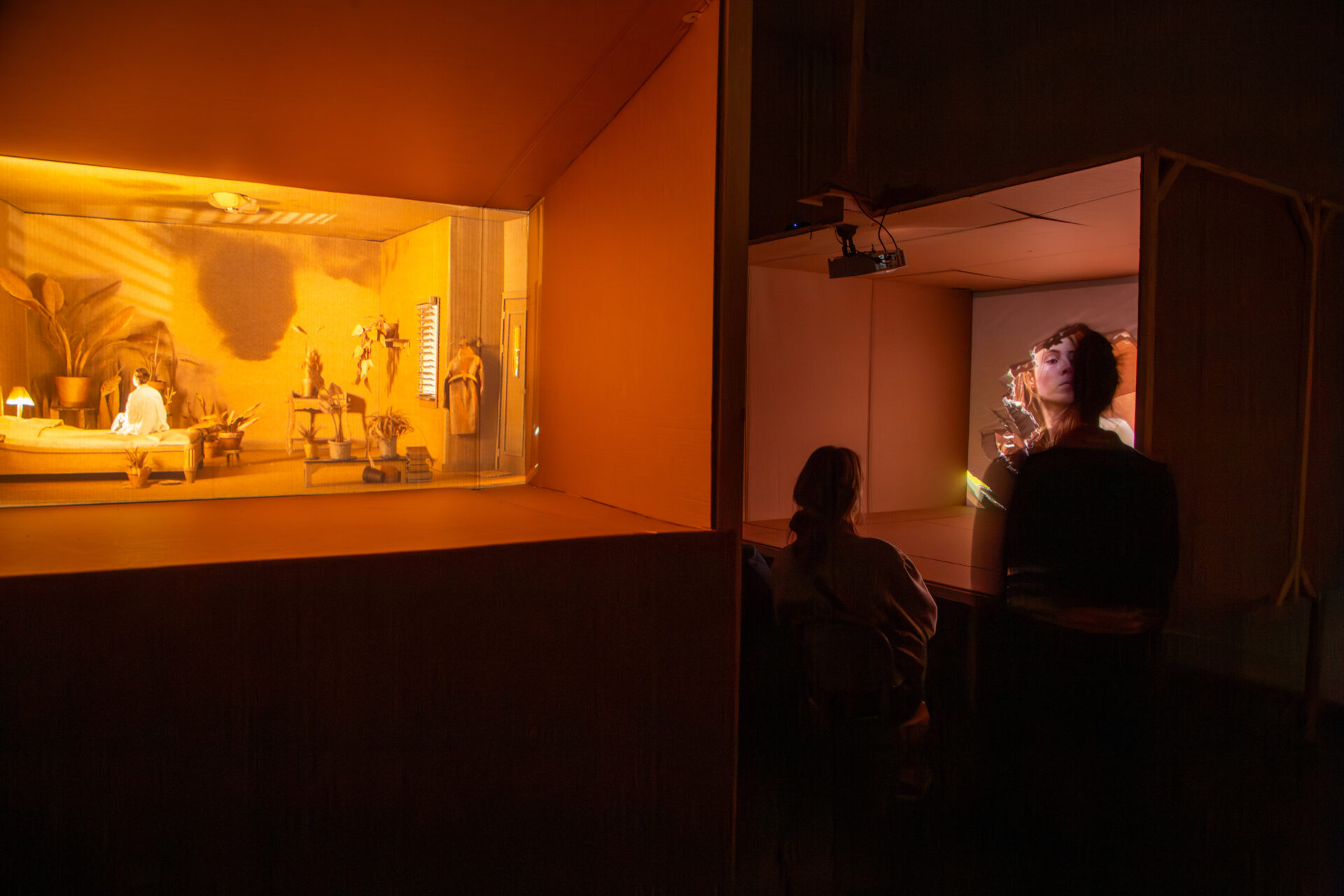
Jemina de Jonge
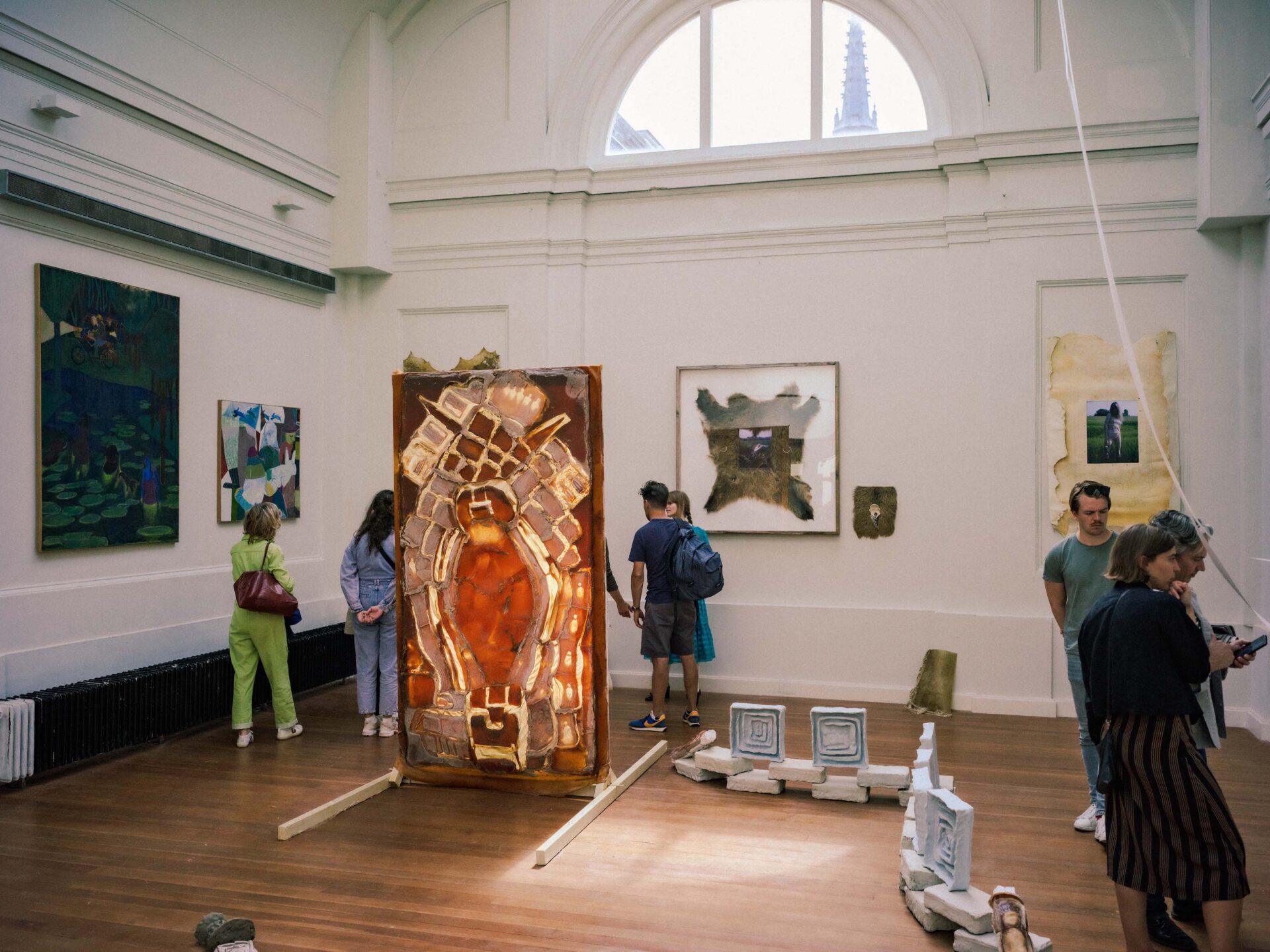
Overview BA Fine Arts and Photography
Hanna Burgers (BA Photography)
Relatively traditional in its photographic documentary form, Hanna Burgers’ Birth Currents investigates the manners in which the process of childbirth has changed in the Netherlands over the last decades. Ranging from highly intimate photographs of births at home to near-scientific imagery of the development of artificial wombs, Burgers reflects on themes of domesticity, autonomy, and medicalisation, all from an angle that centres on the highly emotive nature of childbirth. The installation combines newly created images with archival research, collectively constructing a visual utterance of some of the many ways in which pregnancy, birth, and womanhood are perceived and conceived.
Pregnancy and bodily autonomy regularly appear to be caught up in a regressive moment, with the rights to abortion, adequate health care and fair parental leave consistently facing threats. It is moments like this when the importance of critical image-making practices shines through, establishing their potency through thoughtful and, most importantly, sincere modes of visualisation.
Without telling the viewer what to do, where to look, or what to think, Birth Currents is assertive in its touching, gentle recombination of vulnerability and resilience. Its gaze appears persistent but respectful, empowering rather than imposing. As such, Burgers is subtly (but certainly) aware of the power of the camera, both in terms of its potential violence and penetrative aggression, as well as its capacity to observe, express, and inspire care, awe, and compassion.

Hanna Burgers
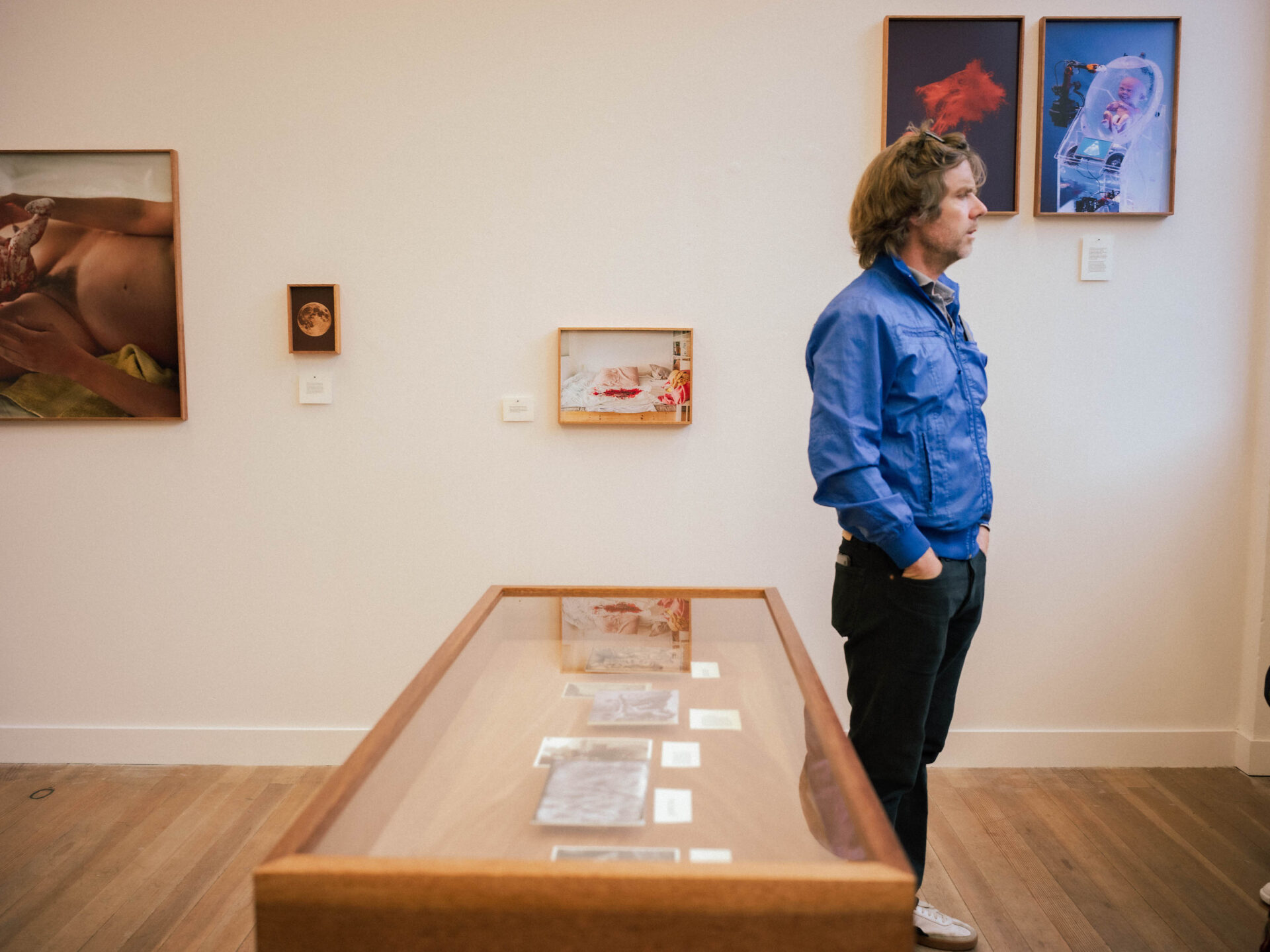
Hanna Burgers
Faria van Creij-Callender (BA Fine Arts)
It’s hard to miss the motif that recurs throughout Faria van Creij-Callender’s Whilst we were playing, they saw it coming; chess boards, traffic lights, and zebra crossings in undoubtedly Dutch contexts provide a clear locus to which the painter attracts the viewer’s eyes. Placing black next to white next to black next to white, Van Creij-Callender dedicates her work to the experience of people existing in the middle of two extremes.
Recalling upon her personal experience of being of mixed heritage, she appears to claim a space that stretches along the spectrum that bridges between the two contrasting shades. Not needing to find solace on either side, but instead constructing and finding comfort and confidence, joy and playfulness in the liminal space between. Whilst often conceived as existing in a dichotomous relationship, black and white are more accurately represented as two sides on a sliding scale or spectrum. The depiction of a mix of more everyday scenes with somewhat absurd situations and spatial abstraction, as well as the inclusion of more sketch-like illustrations of details, renders this project a powerful personal reflection on agency and identity.
It is that space in-between where life exists, where plays are made, where decisions occur. Depicting her own body as the pion (pawn) of the chess board, it is precisely in the traversing of the in-between, crossing borders separating the black and white, that van Creij-Callender regains or re-establishes personal autonomy.
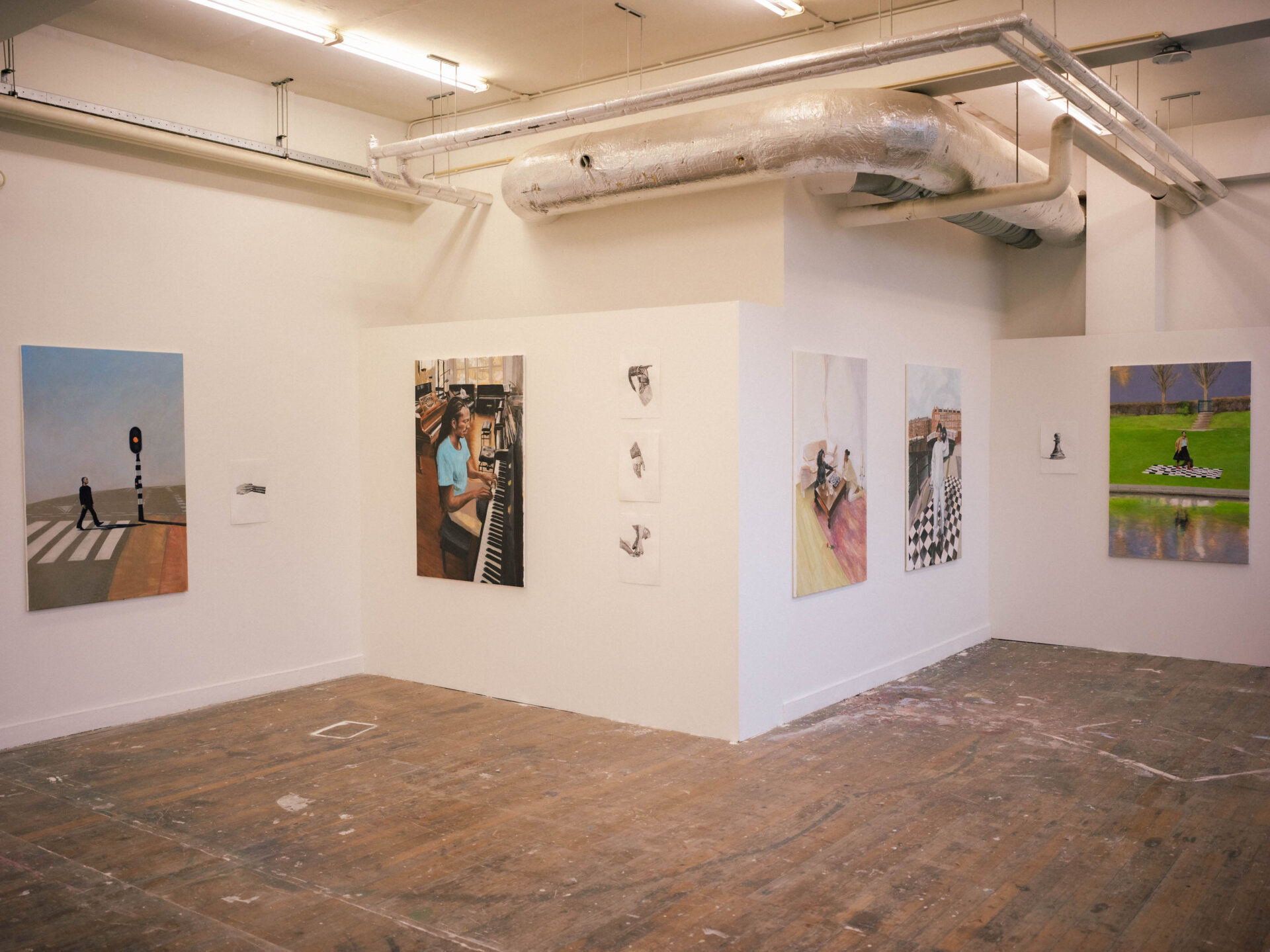
Faria van Creij-Callender
Ira Grünberger (BA Photography)
A pipe, shimmering in its copper-coloured sheen, zigzags its way down from the tall ceiling into the middle of the room that hosts Ira Grünberger’s space of a space reminiscing (Flüstergewölbe). At its end, a cyanotype print is gradually covered by the relentlessly slow drips of vinegar released by the pipe, its material interacting with the liquid, setting in motion the process of oxidation. Around the walls, small, delicate photographic prints are accompanied by rigid steel frames and more traces of rust and discolouring. Grünberger’s work stretches the photographic medium beyond its indexical limitations, extending on the often-overlooked materiality of the photograph. The photograph appears as an imprint, a memory, a trace, a trace of a trace, but most of all, a multisensory object that carries material and spatial specificity. Even the business cards smell like rust, steel, and vinegar.
Grünberger redirects the senses to acknowledge the agency and power of the materials that surround us, especially within the context of the spaces we manually construct ourselves. The entire project, from its images to its installation to its business cards, serves as a reminder of the material histories that are carried by the physical substance of our direct environments. And that these histories are alive: the vinegar dripping ever so slowly, the work has not yet ceased to become itself, its fluid and ever-changing state reflected in the liquid’s potent odour and the complex texture of oxidation that gradually sets over the cyanotype at the pipe’s end.
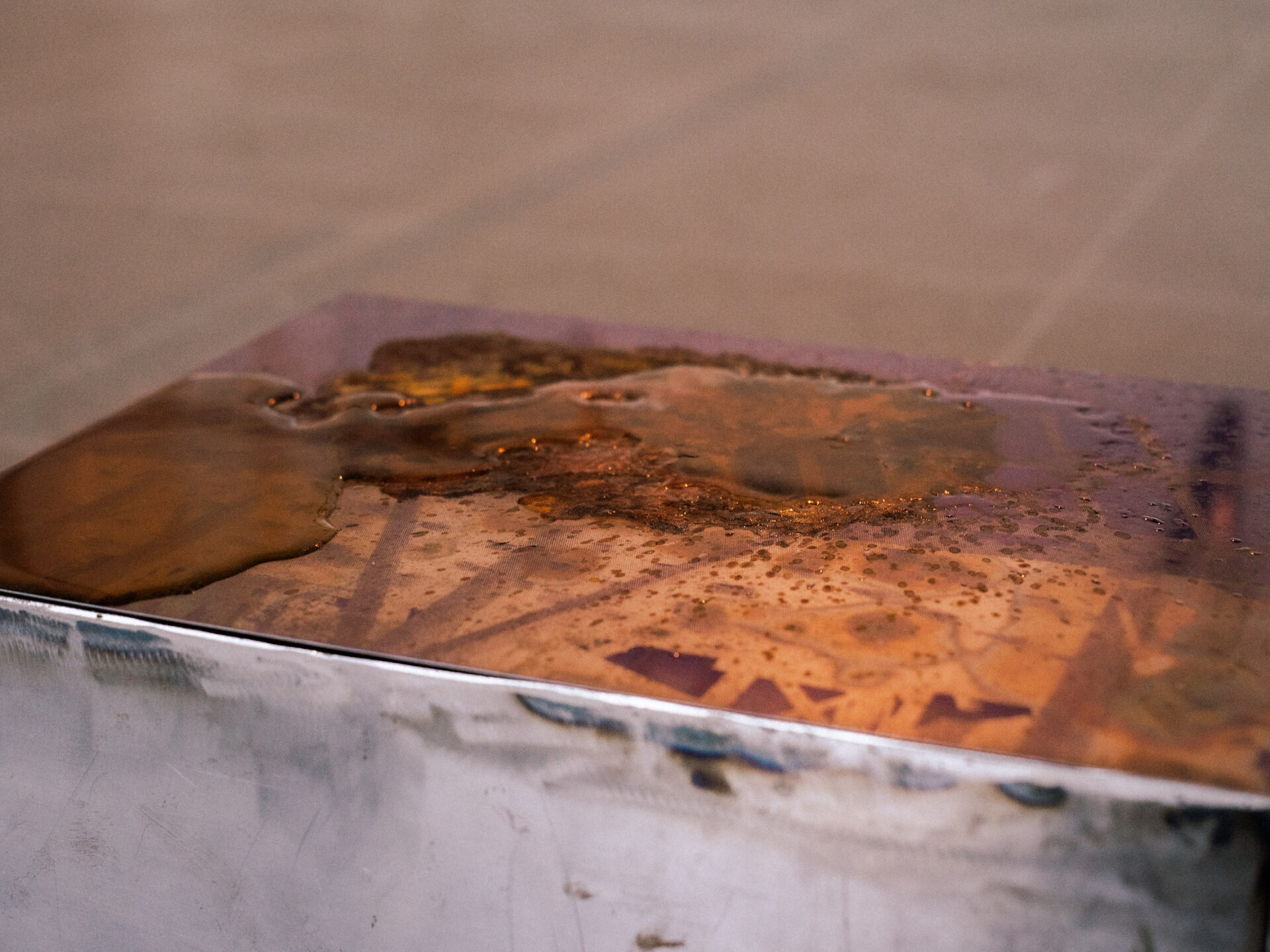
Ira Grunberger
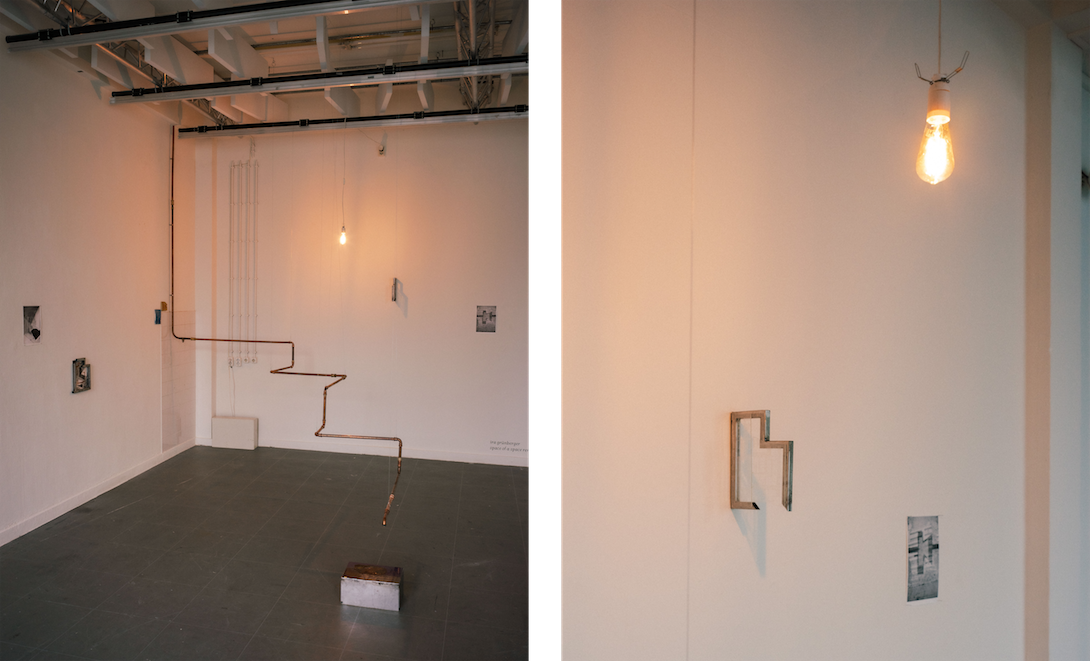
Ira Grunberger
Aldo Brinkhoff (MA ArtScience)
The impatient visitor may walk by Aldo Brinkhoff’s Accelerated erosion of a wall No. 2 and, depending on the moment of passing by, simply pass a glance at a wall that has slightly fallen apart. Those who take time, or who are especially sensitive to light and sound, however, see something else; the shimmer in the wet clay-like mortar in the wall and on the floor before it, combined with occasional slimy, slippery sounds reveal that this wall is in fact falling apart before their very own eyes.
Having developed a technique to accelerate the erosion of his handmade bricks, Brinkhoff constructed a new wall in the grand staircase at the back of the academy that falls apart throughout the days that the graduation show is open to the public. Gradually, the wall disappears, dropping to the floor to form a much less organised mound of grey matter. Especially in its spatial context, Brinkhoff’s wall appears somewhat fatalistic; the grandiosity of the black granite floors and the ornamental pillars and ceilings stand in contrast to the process of deterioration of the newly built wall. Yet, the work refers to the naturalness of destruction; in order for organisms to grow, they must destroy. As such, Brinkhoff’s ‘Auto-Destructive Art’ constructs a regenerative philosophy that diverges from ideas that somethings are natural while others are not.
It’s difficult to ignore the institutional context that this consideration of destruction exists within: the KABK has known its fair share of controversy in recent years, more often than not related to the very structure of the academy’s hierarchies and organisational structure. Whether deliberate or not, Brinkhoff’s work depicts the falling apart of an academy, but retains space for hope and regeneration.
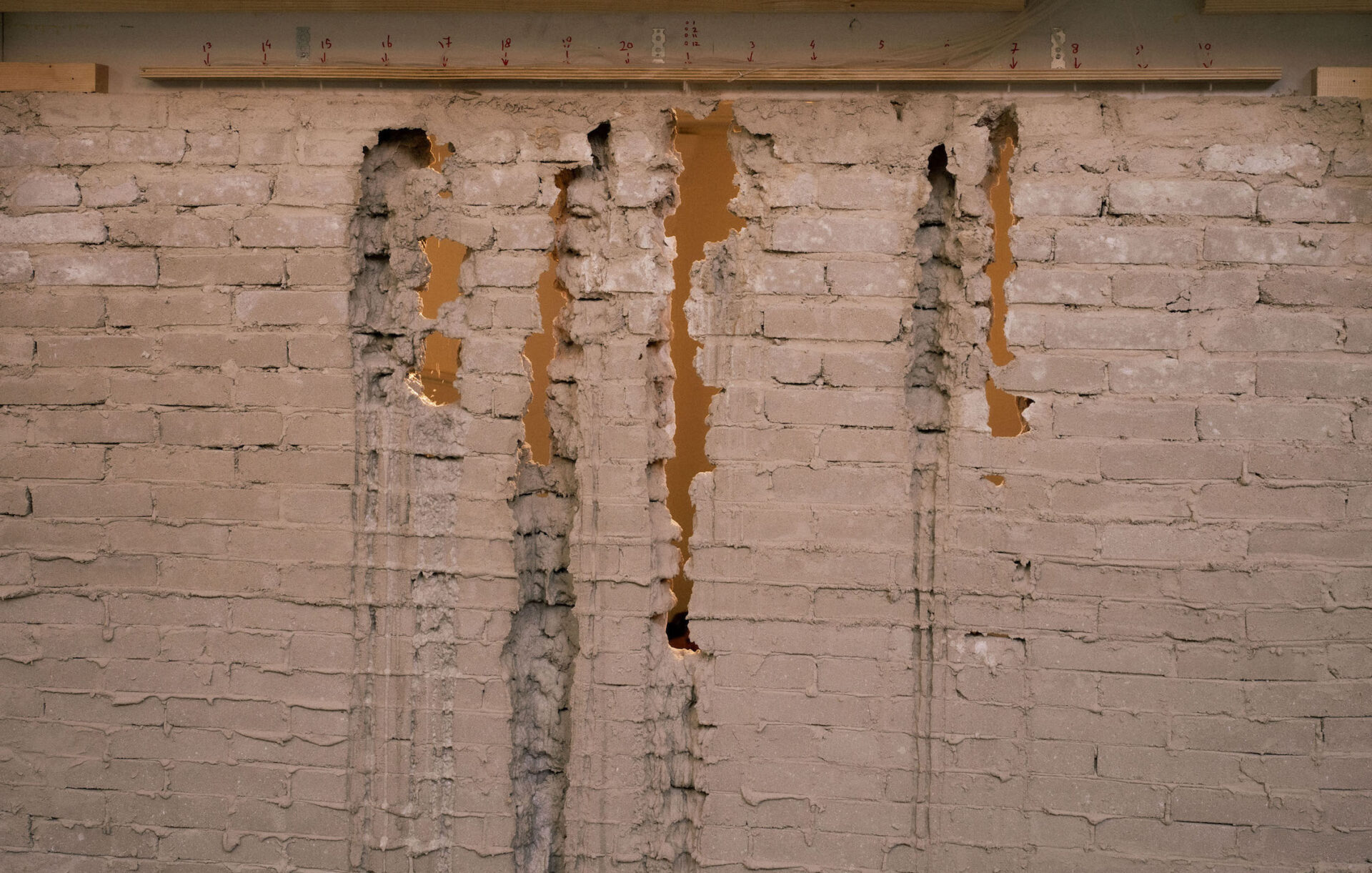
Aldo Brinkhoff
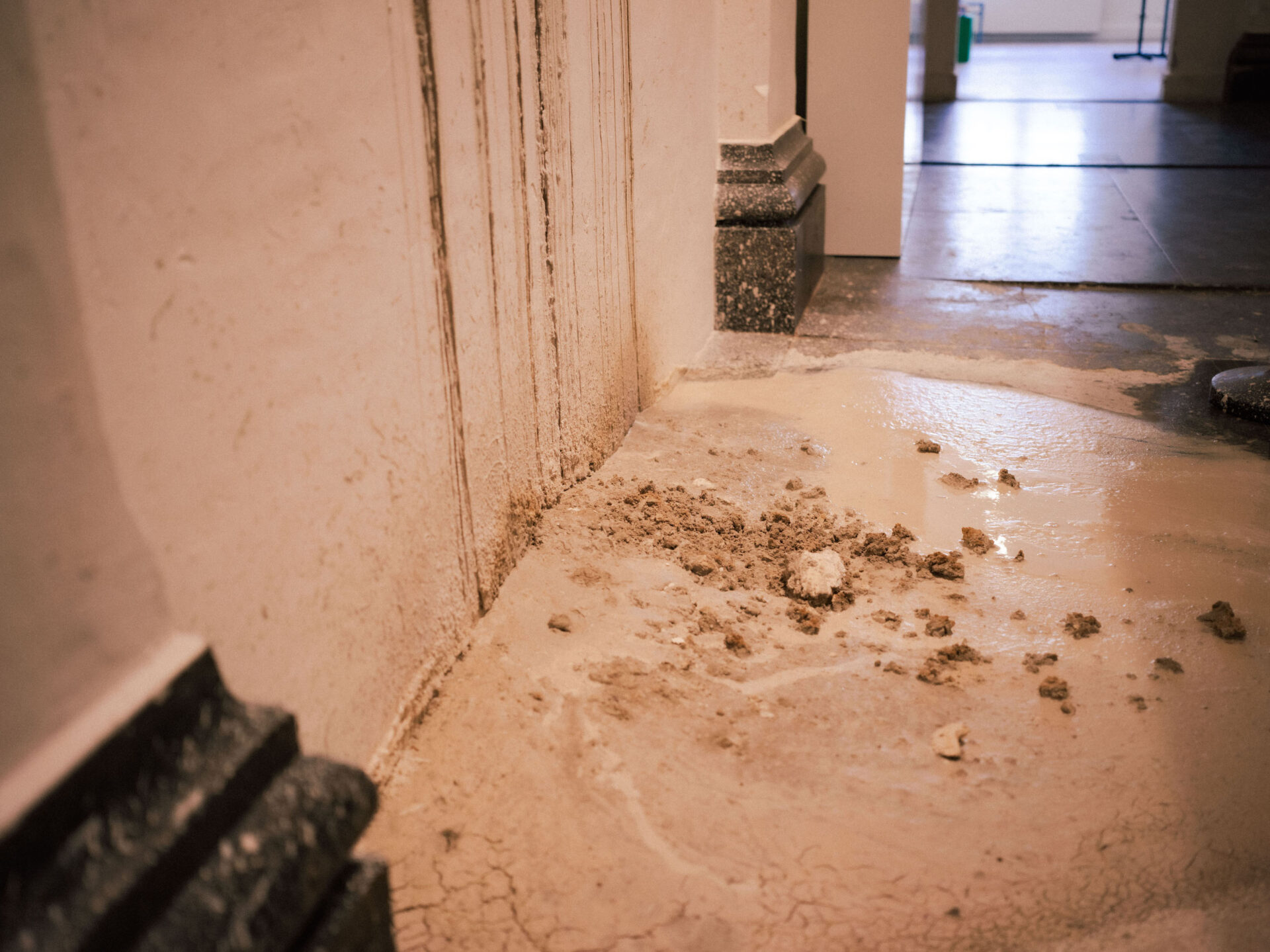
Aldo Brinkhoff
Christian Schwarz (BA ArtScience)
In Somewhere Around 900 MHz, visitors of the graduation show become one with the work that prompted art centre Stroom Den Haag to award Christian Schwarz this year’s Stroom Young Talent Award. The visitor has little control over this; Schwarz’ repurposing of a surveillance tool draws data from nearby telephones using radio technologies which is then converted into a composition of sound art through the use of programming and a self-built instrument. As such, the visitors don’t even realise they are forming the substance on which Schwarz’ work is based.
The inherent violence of this penetrative, unforgiving nature of the work finds a relatively innocent final form: sounds, not necessarily conventionally harmonious or beautiful, but certainly fascinating and enticing. Still, the dissonance of the buzzes and the endlessly warping tones of the artist’s instrument remind the visitor of that which underlies this work: the invasion of privacy through state-sanctioned technology that is generally used by governmental and intelligence bodies inevitably resides within Schwarz’ soundscape.
The uncanniness of that reality sets in as the visitor stands in front of the black screen that rapidly displays numbers, letters, and other information that remains largely inaccessible to the average passer-by. The opacity of the information combines with the haunting mystique of the instrument’s howling to facilitate an investigation into the logistical systems that survey, observe, control. Disorienting and hypnotising, the visitor can hardly escape the consideration of those invisible structures that dictate their lives on a day-to-day basis.
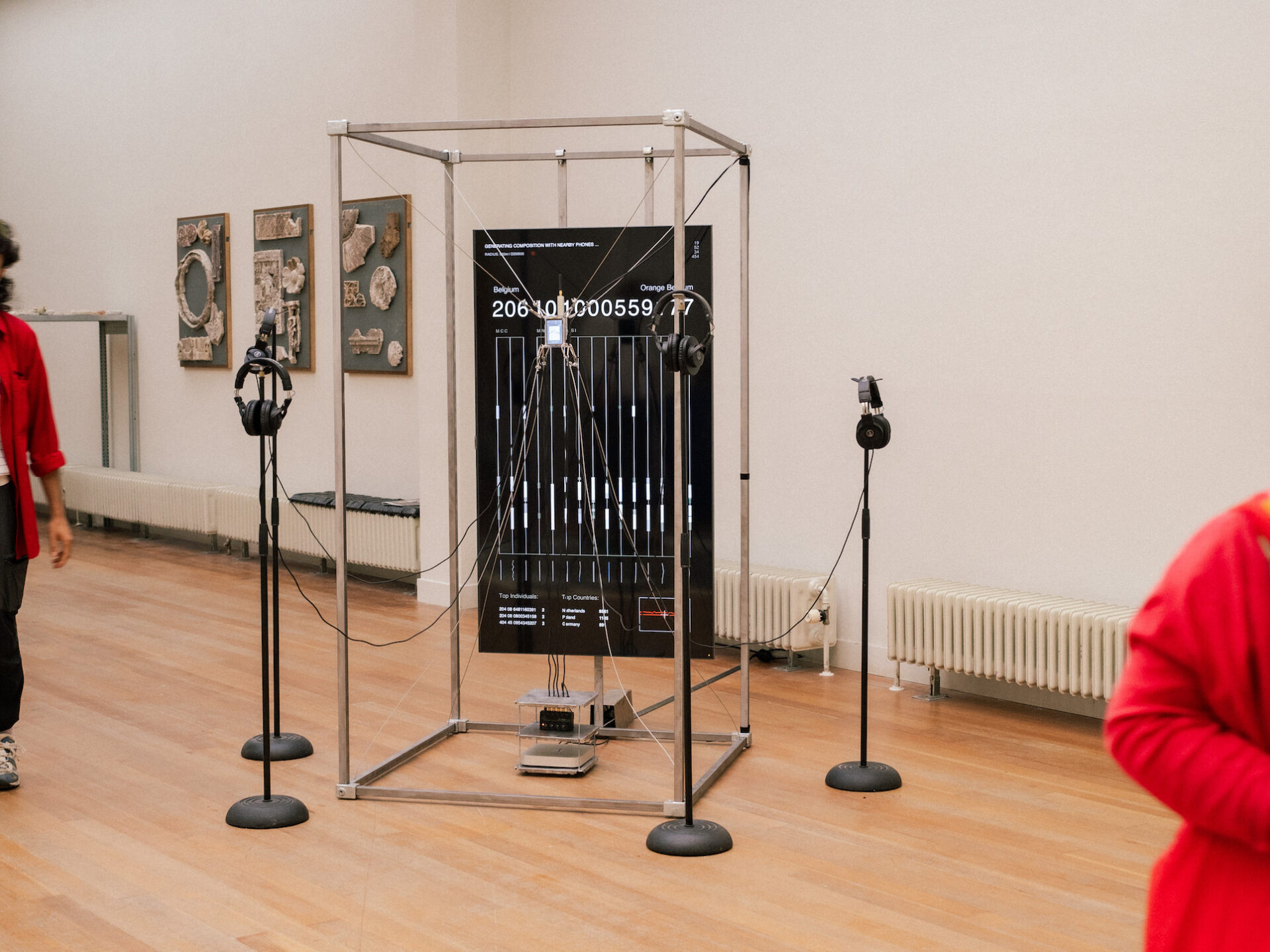
Christian Schwarz
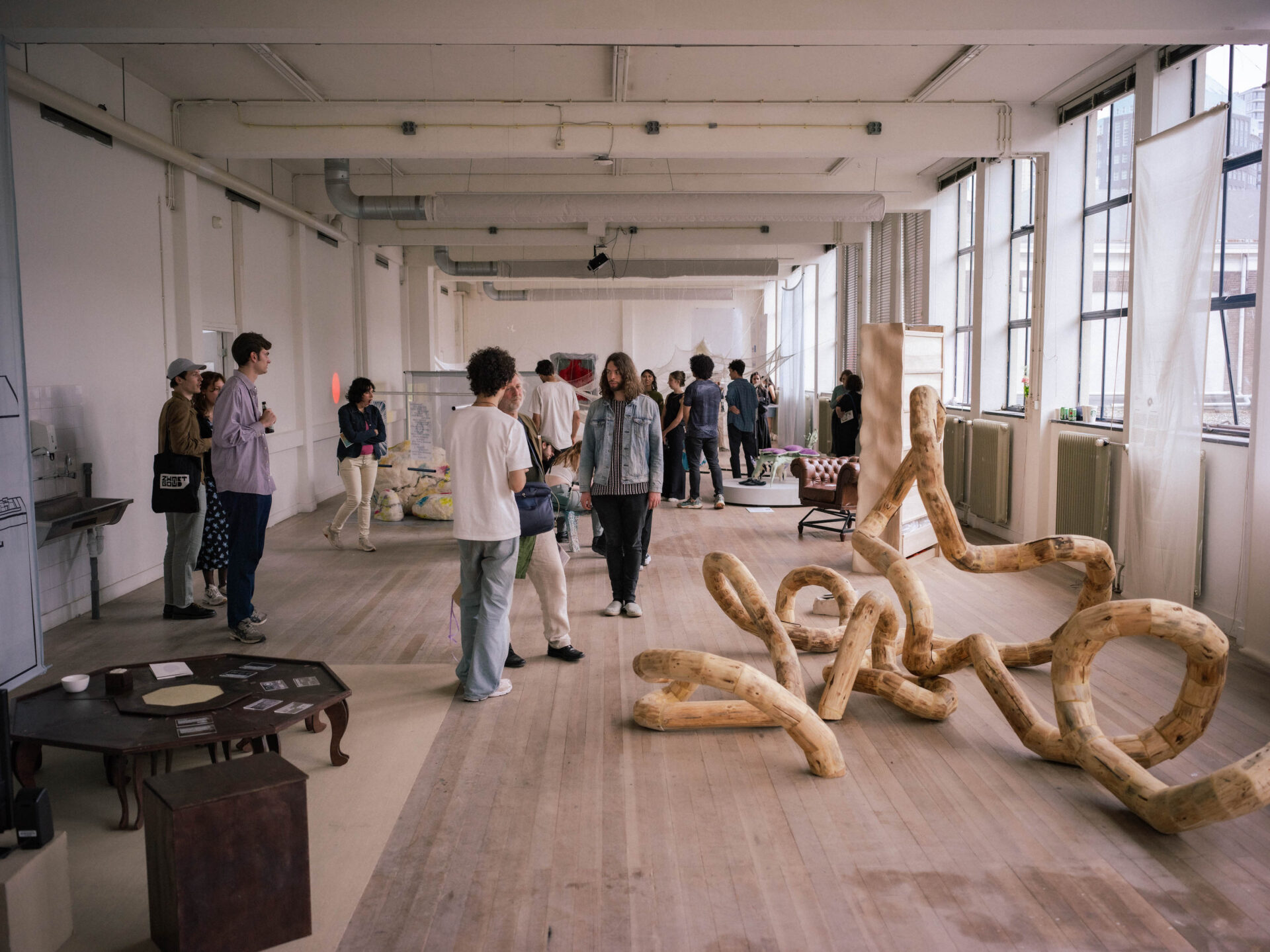
Overview BA Interior Architecture and Furniture Design
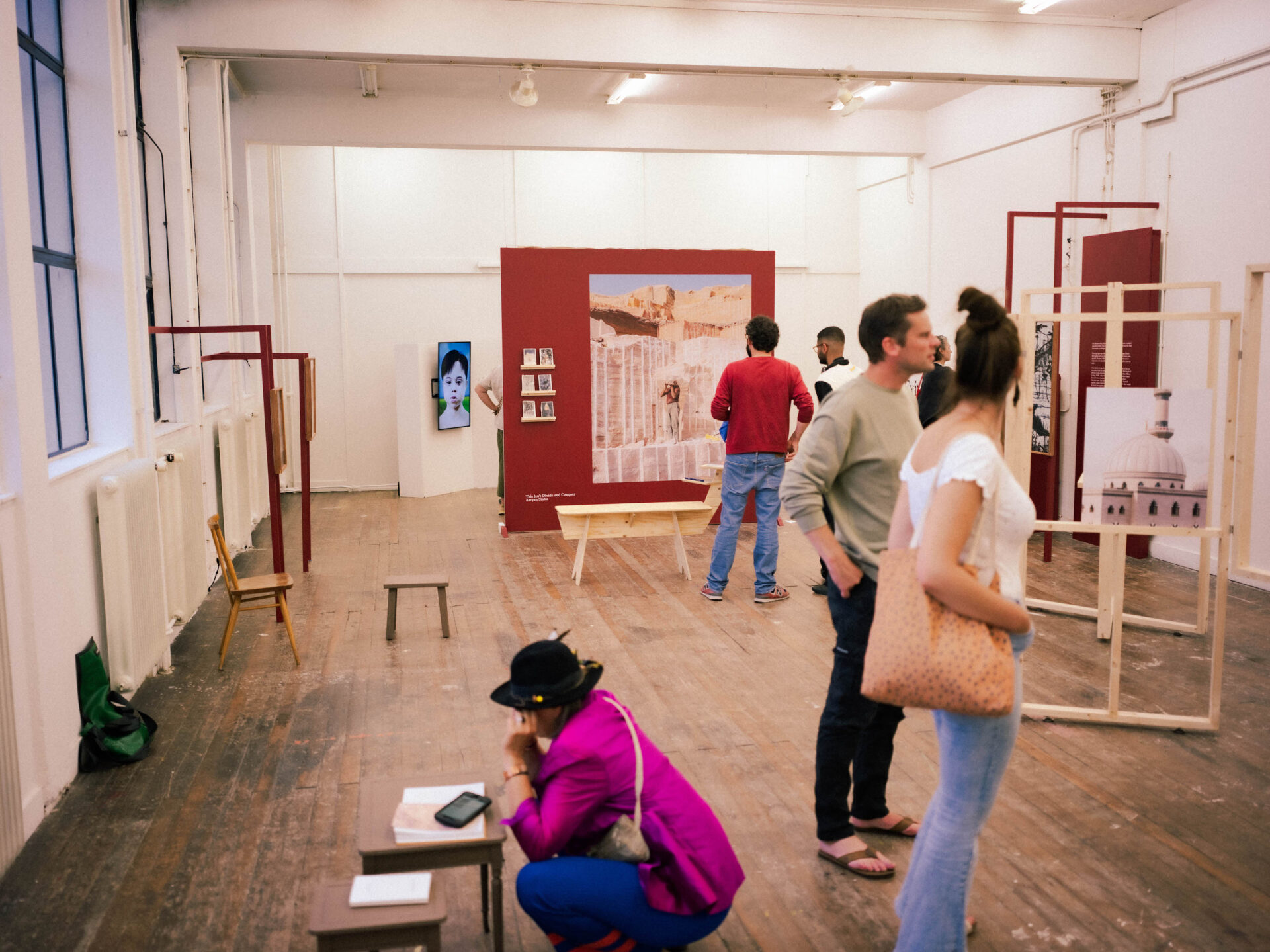
Overview BA Photography
IN AUGUSTUS Bij METROPOLIS M NUMMER 4 PRESENTEREN WE WEER ONS JAARLIJKSE OVERZICHT VAN DE EINDEXAMENS MET PORTRETTEN VAN EEN ZEVENTIGTAL AFSTUDEERDERS AAN NEDERLANDSE EN BELGISCHE KUNSTACADEMIES. ALS JE JE NU ABONNEERT STUREN WE JE DIT NUMMER GRATIS OP. MAIL JE NAAM EN ADRES NAAR [email protected]
All photos are made by the author: Joris van den Einden
The graduation show of KABK, The Hague, is on view until July 4th
Joris van den Einden
is an intern at Metropolis M


